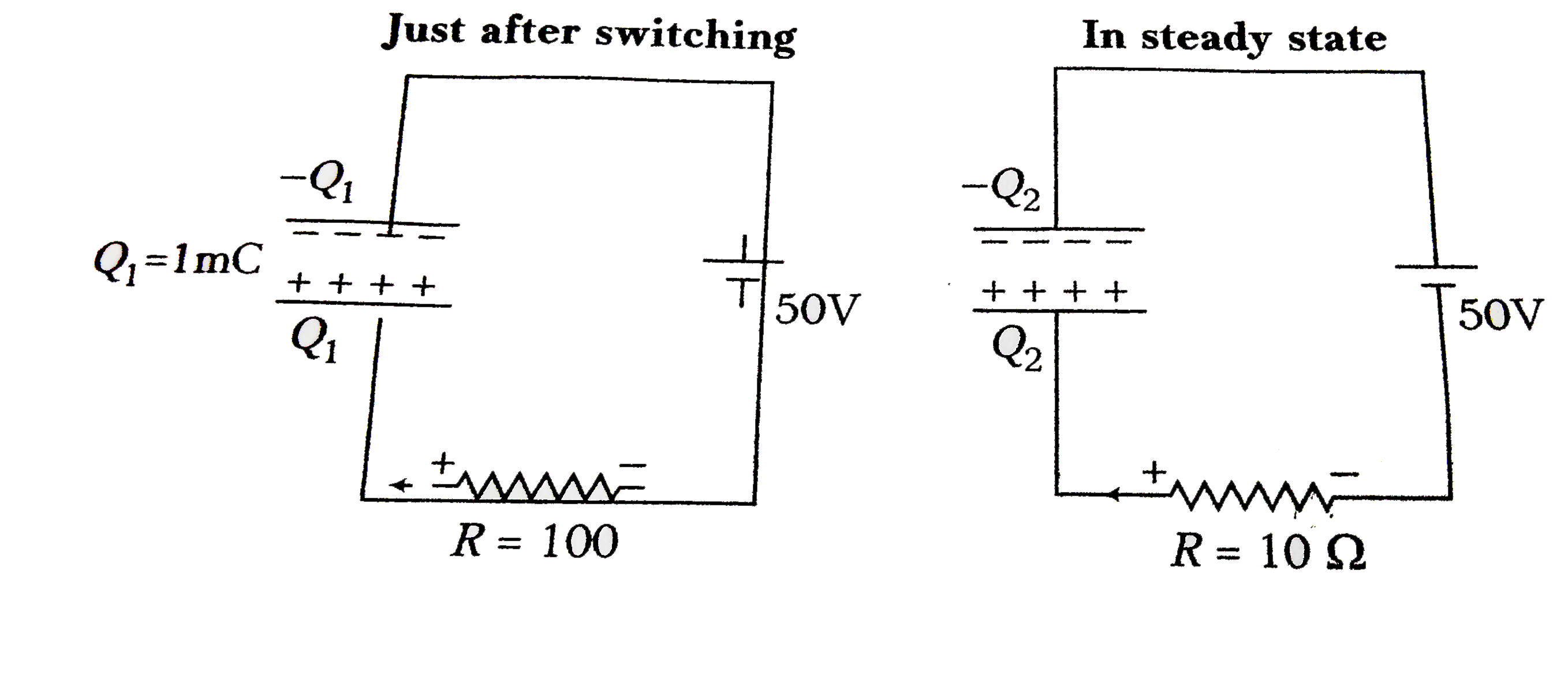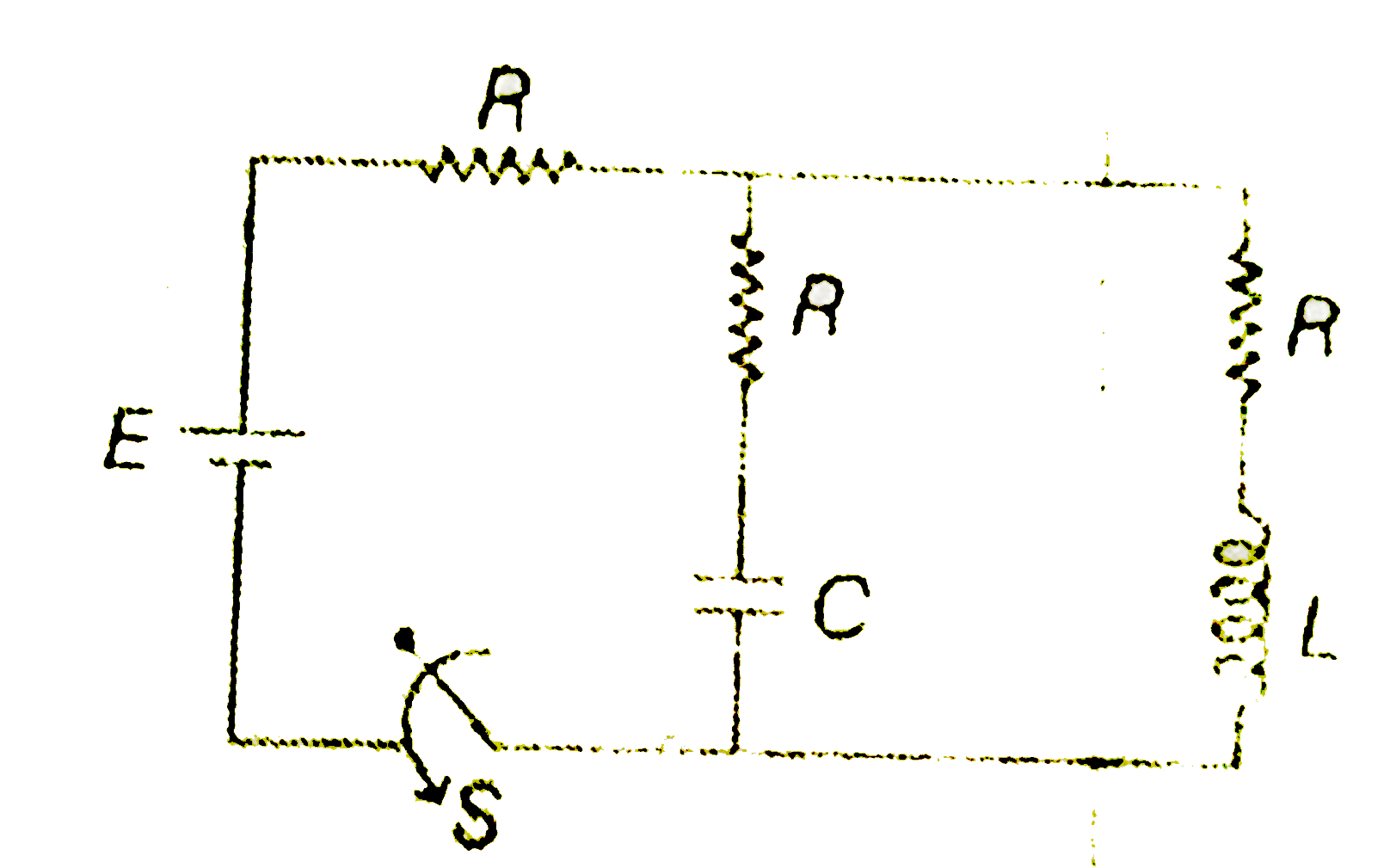At time t = 0 , terminal A in the circuit shown in the figure is connected to B by a key and alternating current I(t) = Iocos(ωt), with Io = 1 A and ω = 500 rads−1 starts flowing in it with the initial direction shown in the figure . At t = 7π/6ω , the keys is switched from B to D . Now onwards only A and D are connected . A total charge Q flows from the battery to charge the capacitor fully. If C = 20 μ , R = 10 Ω and the battery is deal with emf of 50 V , identify the correct statement(s).

A
Magnitude of the maximum charge on the capacitor before t = 7π/6ω is 1×10−3C
B
The current in the left part of the circuit just before t = 7π/6ω is clockwise
C
Immediately after A is connected to D . The current in R is 10 A
D
Q = 2×10−3 C
Video Solution
Text Solution
The correct Answer is:C, D
(c,d) Charge on capacitor will be maximum at t=π2ω
Qmax=2×10−3C
A) Charge supplied by source from t=0 to t=7π6ω
Q=∫7π06Ωcos(500)dt=[sin500t500]0=7π6ω=sin(7π)6500=−1mC

Apply KVL, just after switching.
50QtC=IR=0
⇒I=10A
In steady state Q2=1mC
Net charge flown from battery Q=2mc
|
Similar Questions
Knowledge Check
At time t=0, terminal A in the circuit shown in the figure is connected to B by a key and an alternating current I(t)=I0cos(ωt), with I0=1Aand(ω)=500rads−1 starts flowing in it with the initial direction shown in the figure. At t=(7π/6ω), the key is switched from B to D. Now onwards only A and D are connected. A total charge Q flows from the battery to charge the capacitor fully. If C=20(mu)F, R = 10(Omega) and the battery is ideal with emf of 50 V, identify the correct statement(s).
 .AMagnitude of the maximum charge on the capacitor before t=7π6ωis1×10_3CBThe current in the left part of the circuit just before t=7π6ω is clockwiseCImmediatly after A is connected to D, the current R is 10A.DQ=2×1003C
.AMagnitude of the maximum charge on the capacitor before t=7π6ωis1×10_3CBThe current in the left part of the circuit just before t=7π6ω is clockwiseCImmediatly after A is connected to D, the current R is 10A.DQ=2×1003CAt time t=0, terminal A in the circuit shown in the figure is connected to B by a key and an alternating current I(t)=I0cos(ωt), with I0=1Aand(ω)=500rads−1 starts flowing in it with the initial direction shown in the figure. At t=(7π/6ω), the key is switched from B to D. Now onwards only A and D are connected. A total charge Q flows from the battery to charge the capacitor fully. If C=20(mu)F, R = 10(Omega) and the battery is ideal with emf of 50 V, identify the correct statement(s).
 .AMagnitude of the maximum charge on the capacitor before t=7π6ωis1×10−3C.BThe current in the left part of the circuit just before t=7π6ω is clockwiseCImmediately after A is connected to D , The current in R is 10 A.DQ=2×10−3C
.AMagnitude of the maximum charge on the capacitor before t=7π6ωis1×10−3C.BThe current in the left part of the circuit just before t=7π6ω is clockwiseCImmediately after A is connected to D , The current in R is 10 A.DQ=2×10−3CIn the circuit as shown in the figure, switch S is added at t=0. Then:
 Aafter a long time interval potential differences across capacitor and inductor will be equalBafter a long time interval charge on a capacitor will be ECCafter a long time interval curent in the inductory will be E/RDafter a long time interval current through battery willl be same as the curren through it initially
Aafter a long time interval potential differences across capacitor and inductor will be equalBafter a long time interval charge on a capacitor will be ECCafter a long time interval curent in the inductory will be E/RDafter a long time interval current through battery willl be same as the curren through it initially
Current and voltage in AC are I = Io sin (ωt + π/4), Then
View SolutionIn the circuit shown, the switch is closed at t=0, the currents I1,I2 and I3 are

View SolutionIn the circuit shown key is closed at t=0 with capacitor initially uncharged.

View SolutionIn the circuit shown in figure switch S is closed at time t=0

Current I from the battery at time t is given by
View SolutionIn the circuit shown in figure switch S is closed at time t=0

At what time current through 3Ω resistance and 1H inductor are equal?
View Solution


